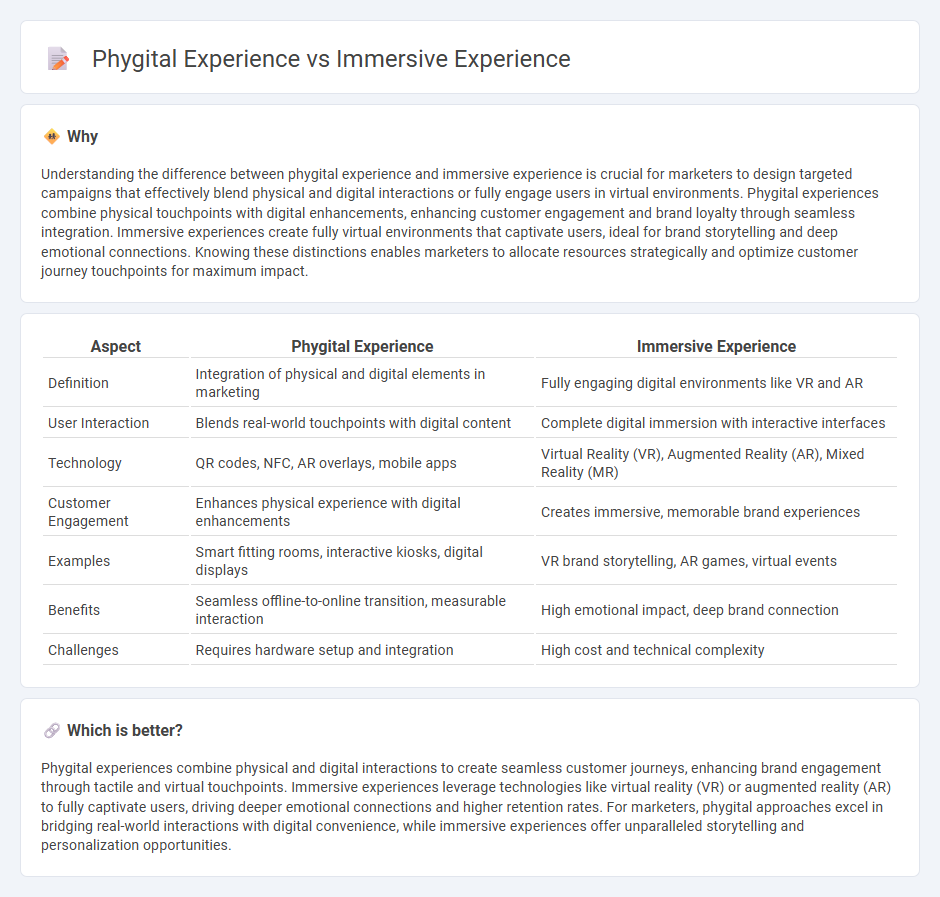
Phygital experience merges physical and digital channels to create seamless customer interactions, enhancing brand engagement through tangible elements combined with digital technology. Immersive experience deeply engages users by placing them in a fully interactive digital environment using augmented reality (AR), virtual reality (VR), or mixed reality (MR) to evoke emotional connections. Explore how these innovative marketing strategies can transform customer journeys and boost brand loyalty.
Why it is important
Understanding the difference between phygital experience and immersive experience is crucial for marketers to design targeted campaigns that effectively blend physical and digital interactions or fully engage users in virtual environments. Phygital experiences combine physical touchpoints with digital enhancements, enhancing customer engagement and brand loyalty through seamless integration. Immersive experiences create fully virtual environments that captivate users, ideal for brand storytelling and deep emotional connections. Knowing these distinctions enables marketers to allocate resources strategically and optimize customer journey touchpoints for maximum impact.
Comparison Table
| Aspect | Phygital Experience | Immersive Experience |
|---|---|---|
| Definition | Integration of physical and digital elements in marketing | Fully engaging digital environments like VR and AR |
| User Interaction | Blends real-world touchpoints with digital content | Complete digital immersion with interactive interfaces |
| Technology | QR codes, NFC, AR overlays, mobile apps | Virtual Reality (VR), Augmented Reality (AR), Mixed Reality (MR) |
| Customer Engagement | Enhances physical experience with digital enhancements | Creates immersive, memorable brand experiences |
| Examples | Smart fitting rooms, interactive kiosks, digital displays | VR brand storytelling, AR games, virtual events |
| Benefits | Seamless offline-to-online transition, measurable interaction | High emotional impact, deep brand connection |
| Challenges | Requires hardware setup and integration | High cost and technical complexity |
Which is better?
Phygital experiences combine physical and digital interactions to create seamless customer journeys, enhancing brand engagement through tactile and virtual touchpoints. Immersive experiences leverage technologies like virtual reality (VR) or augmented reality (AR) to fully captivate users, driving deeper emotional connections and higher retention rates. For marketers, phygital approaches excel in bridging real-world interactions with digital convenience, while immersive experiences offer unparalleled storytelling and personalization opportunities.
Connection
Phygital experience merges physical and digital interactions, creating seamless consumer engagements that enhance brand connection. Immersive experiences leverage augmented reality (AR), virtual reality (VR), and sensory technologies to deepen emotional involvement and drive customer loyalty. Together, they transform marketing strategies by delivering interactive, multi-sensory environments that boost engagement, conversion rates, and customer satisfaction.
Key Terms
**Immersive Experience:**
Immersive experiences leverage technologies like virtual reality (VR), augmented reality (AR), and 360-degree video to fully engage users' senses, creating a compelling digital environment that feels real and interactive. This type of experience enhances emotional connection and brand recall by surrounding users in a multi-sensory, dynamic setting that blurs the line between physical and virtual worlds. Explore how immersive technology transforms user engagement and drives deeper consumer loyalty.
Virtual Reality (VR)
Virtual Reality (VR) delivers immersive experiences by fully enveloping users in digital environments, heightening sensory engagement and presence. Phygital experiences blend physical and digital interactions, using VR to connect tangible objects with virtual enhancements, creating seamless integration between real and virtual worlds. Explore how VR transforms user engagement through immersive and phygital innovations.
Sensory Engagement
Immersive experiences fully engage multiple human senses by using virtual reality, augmented reality, or multi-sensory installations to create a convincing alternate environment. Phygital experiences combine physical and digital elements, enhancing sensory engagement through interactive touchpoints, real-world textures, and digital feedback loops that bridge tangible and virtual interactions. Discover how integrating sensory engagement in these experiences transforms audience involvement and satisfaction.
Source and External Links
Top 5 Guide: Immersive Experiences in Denver - Discover five unique, affordable Denver experiences that transport you into vivid, sensory-driven worlds outside everyday reality.
What is an Immersive Experience? - An immersive experience is a transportive event where you become part of a new environment through integrated sights, sounds, and sometimes even tastes, making you feel as if you're truly somewhere else.
28 Immersive Art Exhibits and Museums Around the World - This global guide highlights cutting-edge immersive art and museum experiences using VR, AR, and digital projections to fully surround and engage visitors.
 dowidth.com
dowidth.com